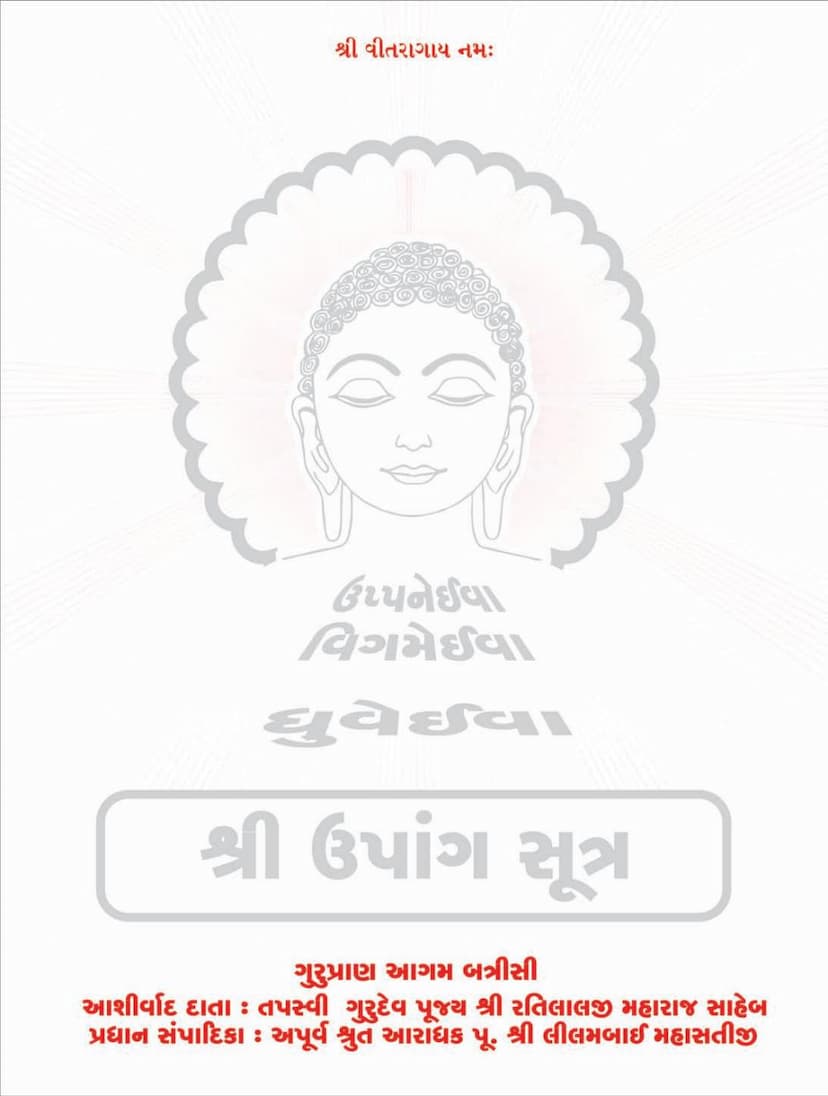Agam 21 Upang 10 Pushpika Sutra Sthanakvasi
Added to library: September 1, 2025

Summary
This is a comprehensive summary of the Jain text provided, based on the translated content of the pages:
Book Title: Agam 21 Upang 10 Pushpika Sutra Sthanakvasi Authors: Kiranbai Mahasati, Artibai Mahasati, Subodhikabai Mahasati Publisher: Guru Pran Prakashan Mumbai
This publication is a part of the "Guru Pran Agam Batrisi" series, dedicated to the revered Gurudev Shri Pranalalji M.S. and Gurudev Shri Ratalalji M.S. It presents the Upaang Sutra (specifically focusing on the Nirayavalikaadi Pancha Varga), with its original text, Gujarati translation, commentary, and appendices.
Key Themes and Content:
- Tribute to Gurudevas: The publication begins with invocations and dedications to the spiritual lineage of the Gondal Gachh, particularly Gurudev Shri Pranalalji M.S. and Gurudev Shri Ratalalji M.S., highlighting their contributions and birth centenaries.
- Agam Literature and its Importance: The text emphasizes the divine origin of Agam literature, originating from the Tirthankaras' teachings, meticulously compiled by Ganadharas, preserved by disciples, and finally codified by Acharya Devardhigani Kshamashraman. It stresses the importance of studying and preserving these sacred texts.
- The Upaang Sutra (Nirayavalikaadi Pancha Varga):
- This section of the Upaang Sutra is divided into five classes (Vargas):
- Nirayavalika: Deals with the conduct of beings leading to hellish states, with detailed historical accounts, including the tragic war between Vaishali and Champapuri. It highlights the devastating consequences of conflict and the harsh realities of karmic retribution.
- Kalpavatsika: Focuses on the lives and journeys of celestial beings, illustrating the fruits of virtuous actions leading to divine realms. It contrasts the rise and fall of individuals based on their karma, emphasizing the importance of righteous conduct.
- Pushpika: This class presents the stories of various individuals, including celestial beings like Chandra, Surya, and Shukra, and human figures like Somil Brahmin. It illustrates the concept of rebirth, the impact of desires, and the consequences of both righteous and flawed spiritual practices. The text discusses the concept of "Viradhit Sammanye" (violating vows) and its implications.
- Pushpachulika: This class features the stories of ten goddesses associated with various virtues and powers, such as Shri Devi, Hri Devi, etc. It details their previous lives and their interactions with Tirthankara Parshvanath, emphasizing the eventual attainment of liberation. It also highlights the importance of maintaining purity in spiritual practice and avoiding excessive attachment to the physical body.
- Vrishnidasa: This class narrates the lives of twelve princes from the Vrishni lineage, followers of Tirthankara Arishtanemi. It details their spiritual journeys, their eventual birth in celestial realms, and their ultimate liberation in Mahavideh Kshetra.
- The Upaang Sutra as a whole is presented as a foundational text that not only narrates religious stories but also offers profound insights into the principles of Jain philosophy, karma, reincarnation, and the path to liberation.
- This section of the Upaang Sutra is divided into five classes (Vargas):
- Biographies of Gurudevas: Detailed life sketches of Gurudev Shri Dungarsinhji M.S., Gurudev Shri Pranalalji M.S., and Gurudev Shri Ratalalji M.S. are included, highlighting their spiritual achievements, ascetic practices, scholarly contributions, and their role in establishing and propagating the Gondal Gachh.
- The "Guru Pran Agam Batrisi" Project: The publication outlines the history and evolution of this project, starting with the birth centenary of Gurudev Shri Pranalalji M.S. in 1997-98, its re-publication in 2009, and the significant contributions of various scholars, translators, and patrons.
- Principles of Scripture Study (Shastra Swadhyay): The text provides guidelines on how to study Agams with reverence, discipline, and respect, including rules regarding auspicious and inauspicious times for study, the importance of a Guru's guidance, and clarifications on issues like impurity in the house affecting the presence of scriptures.
- Detailed Table of Contents and Appendices: The book includes a comprehensive index of subjects, chapter summaries, and explanations of various concepts, making it an accessible resource for the reader.
- Testimonials and Gratitude: The publication expresses gratitude to numerous donors, spiritual guides, and collaborators who supported the project, emphasizing the collective effort in bringing this invaluable work to fruition.
- Editorial and Translator's Notes: The editors and translators share their experiences and the philosophical underpinnings of the Upaang Sutra, highlighting its significance in understanding Jain teachings and the intricacies of karma.
In essence, this publication is a devotional and scholarly endeavor to make the profound teachings of the Upaang Sutra accessible to the Gujarati-speaking Jain community, enriching their spiritual knowledge and understanding of the Jain path to liberation.